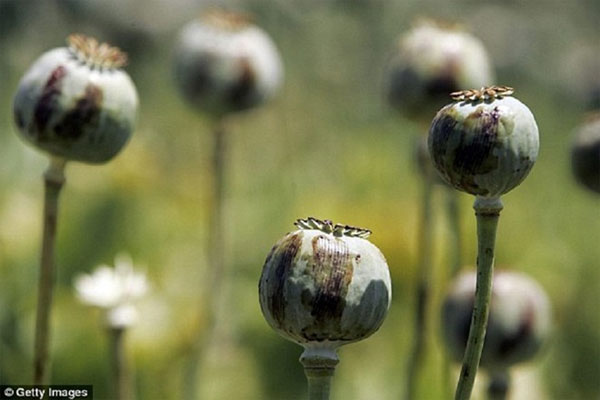People use drugs from prehistoric times
According to a Spanish anthropology professor, humans use hallucinogens and opium poppies from the Stone Age.
Elisa Guerra-Doce, professor of anthropology at the University of Valladolid in Spain, has just released evidence that the Stone Age opium, Daily Mail reported.

Poppies are one of the hallucinogenic plants that humans first grow.(Photo: Getty Images)
According to her, humans began extracting hallucinogenic substances from the cactus in 8600 BC (BC) and growing opium around 6000 BC. She found evidence of poppy cultivation in Italy, Switzerland, Germany and Spain.
The professor also found traces of opium on the teeth of a male skeleton in a cave near the town of Albuñol, in the province of Granada, Spain. The man lived from about 4000 BC.

Echinopsis pachanoi is a cactus containing hallucinations.(Photo: 145 / Liz Whitaker / Ocean / Corbis)
In an article in Time and Mind magazine, Guerra-Doce wrote: 'In addition to the evidence that ancient people use them as food, other findings suggest they also exploit their addictive properties.' .
Some evidence dating from 8600 to 5600 BC shows the ancient inhabitants living in caves in the Callejon de Huaylas, Peru, using Echinopsis pachanoi, a type of cactus containing virtual mescaline. feeling.
Archaeologists discovered traces of cacti and pollen at the Guitarrero cave in the area. They also found red marks on the teeth of a corpse buried 13,000 years ago in the Duyong cave on Palawan island in the southern Philippines. The researchers speculated that the red stain formed from chewing betel leaves. Today, people in some Asian countries still eat betel nuts, which contain mild stimulants.

Archaeologists found that the teeth of prehistoric humans had red marks due to chewing betel nuts in a cave in the Philippines.(Photo: Corbis)
By the Bronze Age, people lived in Turkmenistan's Kara Kurum desert using marijuana and opium in rituals. Archaeologists found burnt seeds in a bowl of Bronze-Pitve Grave culture in Romania in 2100 BC. In addition, they discovered the nicotine on the hair of mummies that existed for centuries before Europeans arrived in South America.
In North America, the pipe appeared from around 2000 BC although it may also be used to attract other plants. Here, researchers also found nicotine in a pipe that dates back to 300 BC.

Prehistoric people in many European and Central American countries used magic mushrooms to hallucinate for a long time.(Photo: Corbis)
Professor Guerra-Doce said that the magic mushroom used to be quite popular, but it has disappeared in history. According to the carvings on the cliffs at the Neolithic period in the Bronze Age in the northwest of Piedmont, Italy, the ancients used them in rituals.
Traces of hallucinogenic mushrooms also appear on some small sculptures dating from 500 BC to 900 AD in Guatemala, Mexico, Honduras and El Salvador.
Professor Guerra-Doce believes that instead of the goal of relieving stress today, prehistoric people use drugs in rituals and rituals. Most of the traces they found were in graves and areas that once had religious significance.

Researchers found evidence that humans have been smoking tobacco plants for thousands of years.(Photo: Corbis)
To date, researchers have not yet learned the details of the ceremony. They hypothesize that people use hallucinogens at funerals to provide nutrients to the deceased on their journey to the afterlife or this is a tribute to the gods of hell.
She believes that prehistoric society restricts the use of stimulants because of their sacred role.
However, she asserted: 'People have been using hallucinogens for many millennia'.
- Unexpected facts about the time of
- Bac Kan: Detecting traces of prehistoric people in Ba Be
- Footprints of 3.6 million years of prehistoric people reveal many secrets
- Fossil findings suggest that cancer has been around since prehistoric times
- Deciphering the incredible life of prehistoric people
- Cloning animal clones from prehistoric times to create Jurassic Park
- Life is equally amazing between modern people and prehistoric people
- Find the oldest stone ax in the world
- Prehistoric people used to eat the dead relatives
- Why are some medicines not chewed, broken or crushed?
- The prehistoric people once genocated large mammals
- The relics in the volcanic cave have bones of prehistoric people in Dak Nong
 Discovered an ancient centipede fossil 99 million years old
Discovered an ancient centipede fossil 99 million years old Discovered bat-like dinosaurs in China
Discovered bat-like dinosaurs in China Discovered a 200-year-old bronze cannon of the coast
Discovered a 200-year-old bronze cannon of the coast Discover 305 million-year-old spider fossils
Discover 305 million-year-old spider fossils